Photo
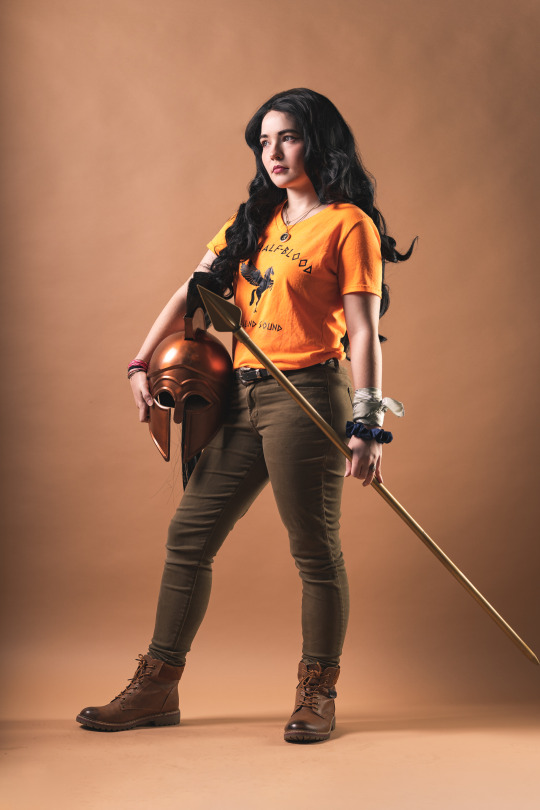
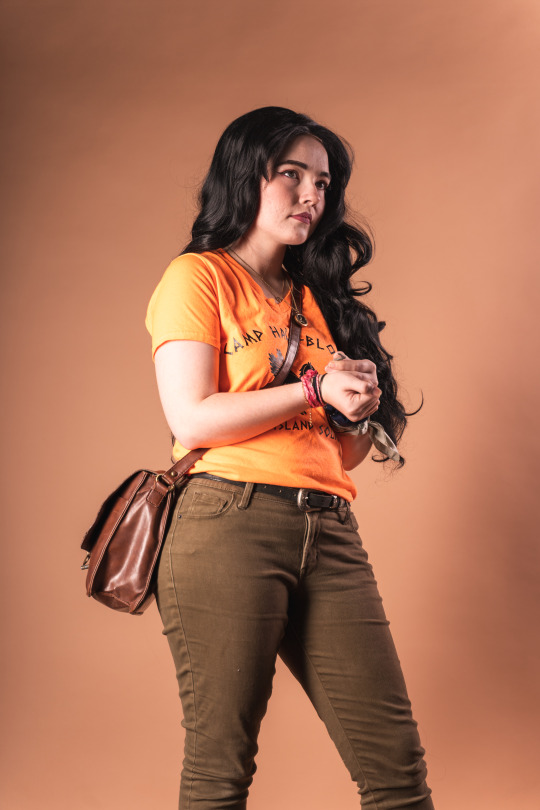
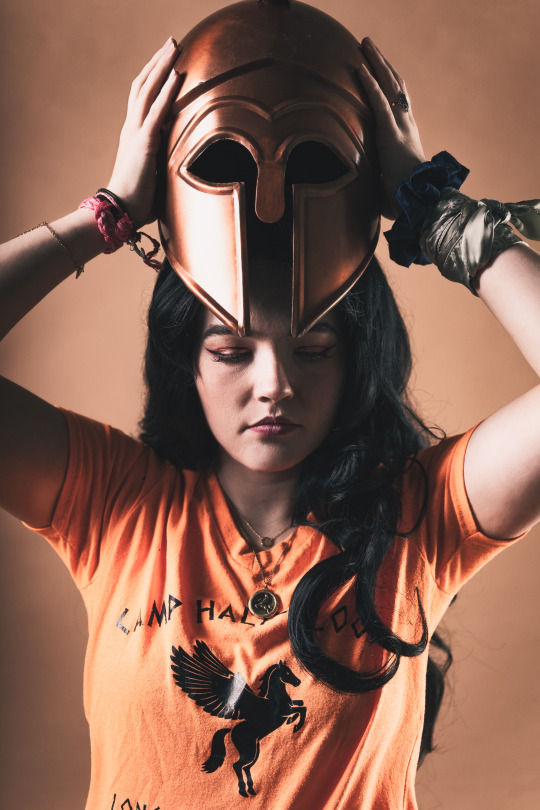
“I'll show them 'love is worthless,'" Silena Beauregard grumbled as she strapped on her armor. "I'll pulverize them!”
Super happy with how these photos turned out.
Do you think Silena was a hero, villian or somewhere in between?
Photogtrapher is H.E-X Photography
#silena beauregard#percy jackson#percy jackson and the olympians#camp half blood#titan army#clarisse la rue#silena pjo
20 notes
·
View notes
Text
Cultural Fashion: Kyoshi Warriors Uniform

As mentioned in a previous post, the leader of the Kyoshi Warriors (Suki) sports a maetengan (前天冠) or “heavenly crown” with a decorative maedate (前立) or “front crest”. The other Kyoshi Warriors wear hachigane (鉢金) or “metal-plated forehead protectors” decorated with maedate. If you’d like example pictures and a more in-depth description, click here.
The Kyoshi Warriors’ fabric clothing are comprised of a bright green kimono/着物 (Japanese robe), dark green hakama/袴 (traditional Japanese trousers), an obi/帯 (sash), and han kote/籠手 (Japanese vambraces).
Over their green kimonos, the Kyoshi Warriors wear hara-ate dō (腹当胴) or “torso armor”. The type of armor they wear is notable as it was initially worn only by ashigaru (足軽) or Japanese foot soldiers. Ashigaru armor is unique for its single-piece, barrel-like torso armor, in contrast to the elaborately plated lamellar-style armor that samurai wore.
The advantages of ashigaru armor was that it was lighter and easier to move around in, as well as being much cheaper to produce. In contrast, samurai armor offered better protection at the cost of speed and agility, which was less of an issue for the horse-riding samurai class. However, the effectiveness of ashigaru armor resulted in many later samurai trading in their fantastically stylish armor for the streamlined and practical ashigaru-style armor.
I bring this up because ashigaru armor fits the Kyoshi Warriors’ sensibilities perfectly. Their style of fighting emphasizes agility and momentum, which ashigaru allows for. Secondly, it emphasizes that the Kyoshi Warriors are very humble people. Ashigaru (foot soldiers) were everyday citizens (mostly farmers) who were conscripted into battle, not high-ranking nobility swearing allegiance to a powerful warlord. Kyoshi Island is a tiny, isolated island made up of small villages so it would have no need for fancy lords or a hereditary warrior class. The Kyoshi Warriors are likely just local girls who volunteered to be trained. This would also explain why the Kyoshi Warriors seem to be pretty open to showing outsiders (Sokka & Ty Lee) their techniques; they’ll teach anyone whose willing.
1K notes
·
View notes
Text
Cultural Fashion: Air Nomad Necklaces

The necklaces that Aang and the other Air Nomads wear are Buddhist prayer beads known as mala (माला) in Sanskrit and threngwa (ཕྲེང་བ) in Tibetan. Mala are used to keep track while one recites, chants, or mentally repeats a mantra; which are spiritual syllables or prayers. Mala help to focus one’s awareness and concentration during spiritual practice, as each bead is meant to be counted after each recitation of the mantra. Mala are usually composed of 108 beads (not including the guru bead), as 108 is a sacred number in Buddhism; although smaller malas composed of a number divisible by 9 are also common. Aang and Gyatso appear to be wearing malas composed of 27 beads, for example.
The largest bead in a mala is known as the meru (मेरु) or “guru bead”. The guru bead represents the relationship between the student and the guru or spiritual teacher. The prominent bead is meant to honor the guru(s) who guided the student.
That we only see Aang wear his mala after he defeats Ozai is fascinating to me. I see it as representing two ideas:
1. That he’s honoring Gyatso and his teachings by wearing a necklace very similar to his. Remember that this was shortly after Aang had spared Ozai’s life, so he is continuing to reinforce that the Air Nomads’ culture will never be forgotten and that the bond he shared with Gyatso will always live on.
2. By displaying the guru bead front and center, Aang is also fully accepting that he is not just the Avatar, but the new spiritual leader of the Air Nomads.
Like what I’m doing? Tips always appreciated, never expected. ^_^
https://ko-fi.com/atlaculture
2K notes
·
View notes
Text
Cultural Fashion: Northern Water Tribe Accessories
If you take a look at the background characters in the Northern Water Tribe, you’ll notice they wear these really pretty tassels on their hats. These accessories are inspired by Korea norigae (노리개). The norigae functions as both a decorative pendant and a good-luck charm. They are believed to bring youth, wealth or many sons, depending on their shape. They are oftentimes heirlooms passed down from parents or in-laws to daughters.
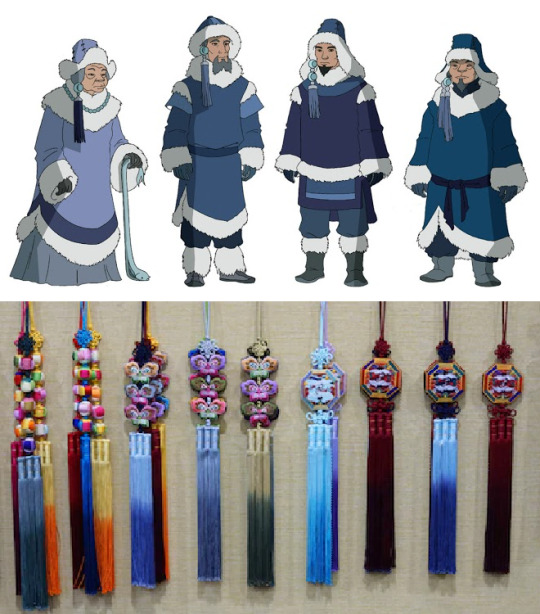
Another NWT background character wears a norigae crossed with a daenggi (댕기), a traditional Korean hair ribbon. Daenggi are worn with braided hair and are used to indicate age and social status.

I really wish we got to spend more time in the Northern Water Tribe, I love their fashion sense.
1K notes
·
View notes
Text
Cultural Fashion: Kyoshi Headbands

Kyoshi and Suki’s headbands are inspired by a combination of two traditional Japanese accessories: Maetengan & Maedate.
Huge thanks to @veryever for elucidating me on the cultural inspiration for Kyoshi’s look. Allow me to quote veryever’s description of the real-life headband:
Tomoe Gozen, a legendary onna-bugeisha or female samurai foretold to be from the late Heian period. She is one of the legendary and historical figures featured in the Jidai Matsuri festival parade in Kyoto.
She’s depicted in parades and other media wearing a maetengan, “まえてんかん” (前天冠), roughly meaning “heavenly crown,” a type of crown that dates back to the Heian period court. Today is commonly worn by Miko, other women, and children as part of dress for ceremonies and dance.
The shape matches with the base of Kyoshi and Suki’s headpieces and the tassels are attached the sides in the front. I’d say it’s not outside of the realm of possibilities someone in the production team had been to the Jidai Matsuri festival or saw photos/video and took some inspo for their samurai inspired female warriors.
On top of their maetengan are their maedate (前立) or “front crests”. These crests were traditionally attached to the front of samurai helmets (kabuto) to help identify the commander and show the status/wealth of the samurai’s lord (daimyo). Since Kyoshi and the Kyoshi Warriors wear crowns rather than helmets, their maedate are attached to their maetengan.

Meanwhile, the Kyoshi Warriors who are not Suki appear to be wearing hachigane, rather than maetengan. Hachigane (鉢金), which translates to “head metal”, were metal-plated headbands that were worn primarily by samurai. One of the most common attacks used by samurai was a downward slice to the forehead. Hachigane provided some protection against these attacks without the movement restrictions of a full helmet. Considering how agile the Kyoshi Warriors are, it’s not surprising they favor this style of armor. I also think the non-Suki KWs are wearing smaller maedates on their hachigane.
1K notes
·
View notes
Text
Cultural Fashion: Avatar Kuruk’s Design
Kuruk - Bear (Pawnee) or to lower one’s head in humility or sadness (Iñupiaq).

Avatar Kuruk’s design takes inspiration from a variety of Inuit, First Nation, and Native American groups. The overall silhouette of his outfit appears to be inspired by the traditional clothing of Gwich’in, a First Nation people native to Alaska and Canada; note the capelet and V-shaped trim at the bottom of the shirt. The elaborate beaded trimming is replaced with fur for Kuruk’s design, but I believe that’s mostly for ease of animation.
His necklace, as mentioned in an earlier post of mine, appears to be based off of bone chokers, which are typically associated with Great Plains tribes. His shoes appear to be inspired by traditional Inuit kamik; which are soft boots traditionally made of reindeer (caribou) skin or sealskin and worn by arctic aboriginal people.
Finally, the bear headdress. It was actually pretty frustrating researching this, since it’s one of those “iconic” cultural items that gets assigned to the entirety of indigenous peoples, much like war bonnets (feather headdresses). One tribe that uses a bear headdress in their cultural practices are the St’át’imc of Lillooet, British Columbia in the Interior Plateau region. The woman featured in the picture is Laura Grizzlypaws, a famous St’át’imc performer. Her St’át’imc name is “Stálhalamcen – Grizzly Paws” and she belongs to the people of Xwisten, the Bear Clan. Grizzlypaws uses bear pelts in dances meant to pay respect to the grizzly bear.
It’s also worth noting that Kuruk appears to be wearing a polar bear’s pelt. According to Wikipedia, in Inuit religion, Nanook (Polar Bears) are considered to be the masters of all bears. Inuit hunters worshiped the Nanook as they believed it was the bear who decided if the hunt would be successful or not. Respect was given to Nanook by the hunter hanging the bear’s hide in a special section of his igloo, where it would stay for several days. Legend says that if a dead Polar Bear was treated properly by the hunter, its spirit would share the good news with other bears who would allow themselves to be hunted. Bears would stay away from hunters who failed to pay respect.
With this context in mind, that Kuruk chooses to wear a polar bear headdress when Aang first meets him reveals so much about his character. First, we immediately realize he must have been a magnificent hunter to have owned such a pelt. Second, he clearly respected what he hunted, as he only wears the pelt when introducing himself to another Avatar; he doesn’t wear it when he’s doing something frivolous, like surfing or making out with his girlfriend. Third, Aang first meets Kuruk when he’s conflicted about taking Ozai’s life. Kuruk chooses to appear before Aang with the headdress on; he’s subtly reminding Aang that taking a life isn’t always an innately malicious or callous act.
So yeah, Kuruk’s a pretty cool guy.
2K notes
·
View notes
Text
ATLA Culture Index: Cultural Fashion - Earth Kingdom
Re-doing my post index series to be more manageable.
Kyoshi Island
Kyoshi Headbands
Kyoshi Makeup
Kyoshi’s Hair & Clothes
Kyoshi Warrior Uniforms
Kyoshi Islanders Fashion Pt. 1
Kyoshi Islanders Fashion Pt. 2
Ba Sing Se
Zuko’s Teashop Clothes
Dai Li Hair Ribbon
Women’s Headdresses
Toph’s EK Looks (cause she’s that special)
Toph’s Headband
Toph’s Hairstyle
Toph’s Fancy Dress
Toph’s Sleepwear
The Rest of the Earth Kingdom
EK Top Knots
The Nomads: Chong
The Nomads: Lily
Serpent’s Pass Refugees Pt. 1
Serpent’s Pass Refugees Pt. 2
Aunt Wu’s Headdress
Bumi’s Outfit
Cabbage Merchant’s Headwrap
Cabbage Merchant’s Vest
The Sandbenders
Earth Kingdom Nuns
Song & Her Mother Pt. 1
Song & Her Mother Pt. 2
Like what I’m doing? Tips always appreciated, never expected. ^_^
https://ko-fi.com/atlaculture
281 notes
·
View notes
Text
Cultural Fashion: Kyoshi’s Hair & Clothes

Kyoshi wears her hair in a very low and loose ponytail. This style is actually iconic to the Heian period of Japanese history. During this time, 794 to 1185, it was considered fashionable for Japanese women to display the impressive length of their hair, either by wearing it free or in a very loose ponytail.
Kyoshi’s clothing closely resembles Tenpyo era (729-749) Japanese fashion. An iconic piece of Tenpyo style were the broad-shouldered vests that women would wear over their kimonos. Kyoshi also sports hakama/袴 (traditional Japanese trousers), an obi/帯 (sash), and han kote/籠手 (Japanese vambraces).
During the Tenpyo Period, the Japanese upper class patterned themselves after the culture of Tang Dynasty China. It was during this period that kimonos were first worn, having been modeled after Chinese hanfu robes. Since Kyoshi Island is a Japanese-inspired landmass in close proximity to a Chinese-inspired kingdom, it’s not surprising that Kyoshi’s clothing borrows heavily from this era of Japanese history.
836 notes
·
View notes
Text
Help me out by re-blogging this post! And come join us today in the chat!

Are you a fan of the Percy Jackson series? We’ve got a panel full of characters from the book ready to answer questions live! Please come join us and any reblog helps!

3 notes
·
View notes
Text
Reblog if you remember this scene in Titans Curse 🛡
⚠️Spoilers for Titans Curse⚠️
9 notes
·
View notes
Text
⚠️Spoilers for Titans Curse⚠️
#thalia grace#percy jackson#luke castellan#pjo thalia#titans curse#percy pjo#percy jackon and the olympians#pjo cosplay#pjo series#pjoverse#cosplay acting
9 notes
·
View notes
Text
SPOILER WARNING
for Shadow of Kyoshi
Ever since reading this portion of the Kyoshi novels I knew I had to make a video of this scene in cosplay. I did change up the ending of the scene from how it plays out in the books.
#avatar the shadow of kyoshi#kyoshi cosplay#kyoshi#avatar: tla#avatar cosplay#avatar#atla#avatar kyoshi#cosplay
12 notes
·
View notes
Text
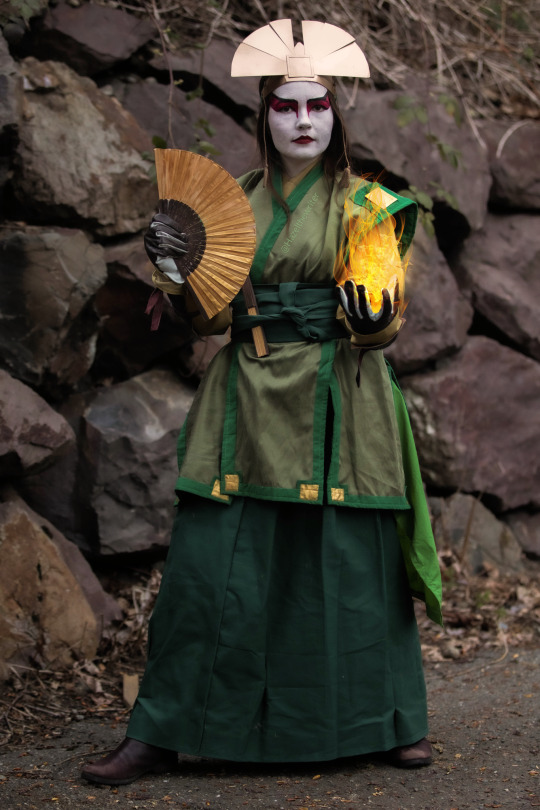
Ahh! I’m so excited about these photos! Finally got some editing done for the flames on my recent Kyoshi shoot photos. There are more to come! A full portfolio will be going up on my website soon.
If folks want to boost this that would be sorta cool 😅
#kyoshi#avatar: tla#avatar kyoshi#rise of kyoshi#kyoshi novels#avatar the legend of korra#avatar: tlok#avatar the shadow of kyoshi#avatar the rise of kyoshi#avatar#avatar the last airbender#kyoshi warriors#Kyoshi cosplay#cosplay#avatar cosplay#atla#atla cosplay
22 notes
·
View notes
Text
Warning- Fablehaven Spoilers without context.
Brandon Mull really pulled the fake-out death thing multiple times throughout the books. And it works each time for some angsty narrative.
#fablehaven#brandon mull#rise of the evening star#grip of the shadow plague#secrets of the dragon sanctuary#keys to the demon prison#kendra sorenson#seth sorenson
19 notes
·
View notes
Text
i genuinely hate when people will make a long post and then put a tl;dr at the bottom that just says “go back and read the fucking post it’s not that long” LIKE,,,,,, TL;DRs ARE ACCESSIBILITY RESOURCES YOU ASSHOLES???? LITERALLY IN THE SAME VEIN AS IMAGE DESCRIPTIONS??????? you HONESTLY do not have to be such a fucking dick about it that you would take an accessibility resource and then twist it just so you can be passive aggressive, honey your neurotypical is showing
32K notes
·
View notes
Text
Secrets Well Kept Chapter Announcement
“Let me make one thing clear, Malfoy,” Andromeda said, making a point to use his last name. “I’m not interested, nor will I ever be, you may as well give it a rest.”
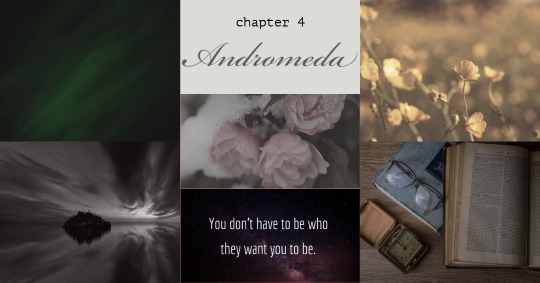
Chapter 4 of Secrets Well Kept is now up on Archive.
Andromeda starts the year off making enemies rather than friends as more and more of her life as she knew it begins to unravel before her eyes. The question remains, is the path she's chosen worth risking not only everything she knows, but also risking everything she could have?
Read it now here- https://archiveofourown.org/works/27818365/chapters/68383360#workskin
And please consider reblogging to support!
#andromeda black#andromeda#young andromeda#ted tonks#narcissa malfoy#lucius malfoy#harry potter fanfiction#harry potter#supportwriters#supportartists#reblogging never hurt anyone and would mean the world to me#marauders era#fanfiction
7 notes
·
View notes
Text
“GRYFFINDOR!” the hat shouted, much to Narcissa’s surprise as she shot a glance at Andromeda who seemed equally surprised. Uneasy murmuring was drowned out by the Gryffindors shouting, as Slytherins whispered about how strange it was, a Black sorted into Gryffindor.

Chapter 3 of Secrets Well Kept is now up on Archive.
Andromeda and Narcissa begin the school year off with a shock as young Sirus black proves to be more of the Black Sheep of the family than they thought.
Read it now here- https://archiveofourown.org/works/27818365/chapters/68281063#workskin
#reblogging never hurt anyone and would mean the world to me#andromeda tonks#andromeda and ted#young andromeda#andromeda black#narcissa malfoy#narcissa#narcissa black#young sirius black#sirius black#lucius malfoy#marauders era#hogwarts#harry potter fanfiction#harry potter#fanfiction#seriously I put a lot of time and effort into writing this story and creating this photo collage
8 notes
·
View notes